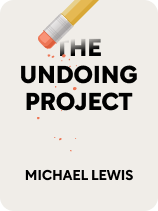

This article is an excerpt from the Shortform book guide to "The Undoing Project" by Michael Lewis. Shortform has the world's best summaries and analyses of books you should be reading.
Like this article? Sign up for a free trial here.
Who are Daniel Kahneman and Amos Tversky? What were their interests and career paths that eventually merged into a revolutionary partnership?
Over the years, there have been collaborations, such as the Wright Brothers or Steve Jobs and Steve Wozniak, whose combined influence far exceeded what they would have achieved on their own. In psychology, Michael Lewis suggests that the quintessential duo was Daniel Kahneman and Amos Tversky.
Continue reading to learn about these two men.
Daniel Kahneman and Amos Tversky
As individuals, Daniel Kahneman and Amos Tversky were unconventional thinkers, but together they amplified each other’s strengths, allowing them to upend behavioral psychology and change the way we understand the foibles of the human mind. We’ll examine Kahneman’s upbringing and early work, followed by Tversky’s parallel path. Then, we’ll take a look at their partnership.
Daniel Kahneman
According to Lewis, the more reserved of the two was Daniel Kahneman, who, from an early age, developed an interest in human behavior, particularly in our capacity for error. Born in Tel Aviv in 1934, Kahneman grew up in Paris and was there for the outbreak of World War II. Kahneman and his family fled to the south, where they hid their existence as Jews. It was there, Lewis says, that young Kahneman became a student of other people’s behavior. His father died before the war ended, and Kahneman’s family moved with many others to the future state of Israel in 1946.
A vocational test pointed Kahneman toward psychology, and, while serving in the Israeli army was mandatory, Kahneman was allowed to go directly to college before having to join the armed forces.
Kahneman went to Hebrew University, the only college accessible to him at the time. Because the school was still piecing together its psychology curriculum, Lewis claims that Kahneman essentially had to educate himself.
According to Lewis, the leading field of psychology at that time was Behaviorism, the study of mental conditioning through stimuli and rewards. Kahneman was drawn instead to Gestalt psychology, which suggested that the mind acted as an interpreter between external stimuli and internal perceptions.
Unlike countries in which psychology was purely academic, Lewis suggests that Israel was interested in its practical applications. Upon graduation in 1954, Kahneman joined the army and was assigned to evaluate new enlistees. He noted that the people interviewing recruits were falling victim to the “halo effect,” in which their first impressions colored all following judgments of a candidate. According to Lewis, Kahneman decided to remove human judgment entirely from the process, developing an evaluative “Kahneman score” based on new recruits’ documented behavior rather than faulty human perceptions. He found that his department’s evaluations improved.
In 1961, Kahneman earned his doctorate from UC Berkeley and began his postgraduate research at the University of Michigan. There, Lewis says, he discovered a conflict between the thinking mind and sensory perception. Returning to Hebrew University, he continued his research into human vision by focusing on what it failed to perceive and how it could be tricked.
Amos Tversky
Amos Tversky couldn’t have been more different from Kahneman. Whereas Kahneman was insecure and sensitive to criticism, Lewis relates that Tversky was energetic, outgoing, and self-assured, with an approach to science characterized by seeing problems through wholly novel angles. Between growing up in Israel, attending school in the US, and returning to his homeland, his academic studies were bracketed by stints of wartime military service.
Tversky was born in Haifa in 1937. Lewis says that, as a boy, Tversky was an athletic thrill seeker. Though he had a natural gift for mathematics, he felt more strongly drawn toward the humanities. He was also brave; in between high school and college, he volunteered as a paratrooper and fought in the war of 1956. (Shortform note: The war of 1956, also known as The Sinai War, the Suez Crisis, and the Tripartite Aggression, began when Egypt took control of the Suez Canal in response to a lack of British and US economic aid. In an effort to reclaim the canal, Britain and France enlisted Israel’s aid in taking control of the Suez Peninsula.)
Once he was able to attend Hebrew University, Tversky studied psychology, though, according to Lewis, he began to feel that much of its research was unscientific. However, his interest was sparked by a research paper that put forward the process of making decisions as a field of study. Intrigued, in 1961 Tversky enrolled in the Ph.D. program at the University of Michigan, which boasted the world’s premier psychology program. (Shortform note: The University of Michigan’s psychology department grew out of the school’s philosophy program in the early part of the 20th century and is still ranked as one of the top psychology schools in the country.)
Lewis points out that, until then, decision-making had been studied by economists who assumed that people made choices rationally. An implication of this belief was the transitive nature of preference. For example, if a person prefers steak to chicken, and chicken to fish, then they clearly prefer steak to fish. (In math terms, if A>B and B>C, then A>C.) However, Tversky’s research showed that preferences are intransitive and that sometimes that same person would choose fish over steak, (C>A). (Shortform note: Despite the evidence supporting Tversky’s view that preference is intransitive, there’s still a body of research in favor of the older principle.)
Tversky studied under Clyde Coombs, who believed that people evaluating any given choice compare it to an internal idealized image—the perfect steak, or the perfect chicken—and decided based on how closely reality matched their imagined ideal. (Shortform note: Some psychologists believe that similarity judgments based on an idealized image govern our choice of romantic partners. In Getting the Love You Want, Harville Hendrix and Helen LaKelly Hunt argue that people fall in love when they meet someone who closely resembles their imagined ideal of their childhood caregivers.)
Tversky hypothesized that people make judgments based on “features of similarity,” only taking into account the features that they happen to notice. Lewis points out that Tversky’s approach solved the intransitivity problem by asserting that the features people use to make decisions are dependent on context. For instance, the hypothetical person above might prefer steak if they’re drinking red wine, or they might prefer fish when visiting a place known for its seafood. Tversky’s ideas also predict what’s known as the framing effect—the principle that decisions can be manipulated by reframing the context in which they’re made.
(Shortform note: The framing effect has been shown to influence individual judgment and public opinion. While some people view framing as a useful leadership tool, others question whether its use in the political landscape leads to a poorly informed and easily manipulated populace.)
This work began the pattern that Lewis asserts would define Tversky’s career—he would examine widely held scientific beliefs, find chinks in their armor, and take them apart. (Shortform note: Tversky’s 1996 obituary notes his thought-changing impact on the fields of economics, business, philosophy, and medicine while praising his intellectual rigor and gifts as a storyteller.)
While pursuing his research, Tversky married psychologist Barbara Gans in 1963. He earned his doctorate in 1965 and returned with his wife to teach at Hebrew University, but shortly after, he was called back to duty to command an infantry unit in the war of 1967.
(Shortform note: The Six-Day War of 1967 between Israel, Syria, Jordan, and Egypt erupted after years of tension along the countries’ borders and within the West Bank. Israel achieved victory through air superiority and tripled in size from lands captured from its neighbors. The shock of their defeat reshaped the Arab political landscape and paved the way for the rise of Islamism.)
The Collaboration Begins (1969-73)
Though their lives had not intersected as yet, when they did finally meet, Kahneman and Tversky sparked in each other an intense collaboration that magnified their individual insights. According to Lewis, Kahneman’s understanding of the fallibility of perception mixed with Tversky’s persistent questioning and mathematical rigor let them demolish the common assumption that human thought is based upon reason.
Though they were colleagues at Hebrew University, their first real interaction took place in 1969 when Kahneman invited Tversky to speak at one of his classes. Tversky discussed research that showed that humans were unconscious statisticians—that guesses people made roughly matched up with mathematical statistical predictions. (Shortform note: The research Tversky referenced related to Bayes’ Theorem, a formula for calculating probabilities under varying degrees of information. In 1968, Ward Edwards proposed that in uncertain situations, people made guesses as if they were unconsciously using Bayes’ Theorem, albeit conservatively.)
Kahneman disagreed. He knew from his research that the senses could be fooled. Why not the mind as well? Lewis recounts that Kahneman argued strongly with Tversky, citing the various cognitive errors he’d seen his own students make. Tversky was troubled by the doubt he introduced, but, instead of becoming antagonistic, the two psychologists chose to join forces and test whether the subconscious uses statistics to make judgments.
To investigate their problem, they devised a questionnaire that would pose an array of statistical questions purposefully designed to trip up the people being tested. Lewis writes that their collaborative style was to lock themselves in an office or classroom to hash out the details of their work. People passing by would often hear a mixture of shouting arguments and raucous laughter as the two worked out the various tricks they would embed into their questionnaire.
(Shortform note: While Kahneman and Tversky’s study may seem unorthodox, their methods weren’t. Questionnaires are a standard research tool in psychology, allowing scientists to collect information from large groups of people. However, they rely heavily on self-reporting and the subjects’ willingness to provide honest answers.)
Instead of inflicting their questionnaire on hapless students, Tversky and Kahneman took it to professional statisticians. The statisticians should have answered the questions correctly, yet they didn’t. What’s more, Lewis claims, the mistakes made by trained statisticians were consistent across the board. Chief among these was what Kahneman and Tversky dubbed “The Belief in the Law of Small Numbers,” a cognitive error in which a person assumes that a small sample of information is representative of a larger whole.
According to Lewis, Tversky and Kahneman’s paper on the subject called into question the bulk of social science research because, when conducting surveys across populations, social scientists vastly underestimated the number of participants needed to provide meaningful data. (Shortform note: In How to Lie With Statistics, Darrell Huff argues that an appropriate sample group is large and random, while those who use small sample sizes can easily distort their data to fit any outcome. In order to avoid the type of error that Kahneman and Tversky identified, researchers today can use a sample size calculator to determine how many survey respondents they need to accurately represent a population.)
Meanwhile, says Lewis, a body of evidence was growing that even expert opinions were marred by faulty thinking. Scientists at the Oregon Research Institute began to study how experts actually drew their conclusions, as opposed to how they claimed they did. In 1970, Tversky went there to further his work, while Kahneman continued his research at home in Israel.
| The Oregon Research Institute The Oregon Research Institute was founded in 1960 by Paul J. Hoffman to collect information on human behavior for use in education and mental health research. It works independently of any governing academic body, though it’s primarily funded by the National Institutes of Health and the US Department of Education. Working at the Institute, researcher Lewis Goldberg led the above-mentioned charge to establish that so-called “expert judgments” were dubious at best. He published a report in 1968 that called into question the accuracy of clinical psychologists’ judgments regarding their patients, showing that experts inflate the accuracy of their predictions and that their accuracy doesn’t even improve in the presence of additional information. |
The Duo in Action (1973-1977)
In the years following the 1973 Yom Kippur War, Kahneman and Tversky were particularly troubled by their government’s failure to predict the attack. They shifted their focus to examine the decision-making process and gave birth to a theory that overturned our understanding of human behavior in general.
In order to stave off a similar surprise attack in the future, Kahneman and Tversky tried to convince the country’s policy makers to calculate probabilities and play the odds. However, when they tried to teach the government about statistical analysis, they learned that generals and leaders always favor their instincts.
Lewis writes that prior studies of decision-making revolved around hypothetical gambles. In order to build a more accurate model of human decisions, Tversky and Kahneman decided that emotions, not just probabilities and economic value, must be taken into account. They found that people are much more open to taking risks if it means avoiding loss instead of making gains.
In 1975 Kahneman and Tversky worked together on creating “risk-value theory,” also known as “prospect theory,” which balanced human decisions based on gains and losses and laid bare the patterns of seemingly irrational human behavior. At the time, economics theory asserted that the irrational errors people made were random and would be corrected by the market. Prospect theory, however, showed that humans are irrational in consistent, systematic ways, and that irrationality is built into the economic market itself.
Separate Ways (1978-1996)
While Kahneman and Tversky were knocking down the pillars of psychology and economics, they were also undergoing upheavals themselves. Lewis claims that their newfound stardom in the academic world, coupled with changes in their personal lives, put their partnership on tenuous ground that affected them both in different ways. Their relationship shifted through the 1970s and ’80s such that Tversky received more and more credit, while Kahneman began to feel resentful of his partner’s antagonistic style, until he felt they could no longer work together.
The first major change to affect their partnership was when Kahneman divorced his wife and left Israel to strike up a relationship with a colleague, Anne Treisman. Tversky left Israel to follow Kahneman, and American universities scrambled to hire him. Lewis states that many in academia gave Tversky more credit for their work, mainly because he was more outgoing, and his contributions were more grounded in math. In 1978, Kahneman settled at the University of British Columbia, while Tversky took a posting at Stanford. Their partnership would now be conducted long-distance.
(Shortform note: The University of British Columbia is a well-regarded research institution, but Stanford University is considered more prestigious, counting Nobel laureates and billionaires among its faculty and alumni. While the two psychologists researched and published their work jointly, Tversky was often given singular credit, such as in this 1998 article which implies that Kahneman was merely Tversky’s coauthor. However, it’s understandable that people were drawn to the more extroverted Tversky—in Quiet, Susan Cain acknowledges that society itself values the qualities of extroverts more than those of introverts.)
Public Perception
Because of their geographic separation, Kahneman developed most of his work on Undoing without being able to bounce ideas off his partner. Lewis notes that Tversky contributed some material to the project, but he spent much of his time giving lectures abroad. Tversky, for his part, thought they were still a team. But, over the next few years he began to receive awards and recognition, while Kahneman was largely left out.
Lewis makes it clear that Tversky rebuked anyone who painted him as the more important of the pair. Nevertheless, he was the one whom other academics came to for insights on how prospect theory related to their work. Kahneman was aware of Tversky’s spotlight and recognized that he’d grown envious of the recognition his partner was receiving. (Shortform note: In academia, where reputation is valuable currency, it matters very much who’s given credit for an idea. However, reacting with anger and resentment is often counterproductive. Claiming credit back when it’s unfairly given elsewhere does require an active effort to assert ownership for your contributions, which unfortunately went against Kahneman’s style.)
Throughout the ’80s, they continued to publish papers jointly, though each was written mostly by one and not the other. Their work also began to be attacked by academics whose research they’d thrown into question. Some challenged prospect theory in particular, while others rejected Kahneman and Tversky’s basic premise that human beings are fundamentally irrational.
(Shortform note: Present-day opponents of prospect theory criticize it for being too mathematical, relying on restrictive assumptions, and not taking neurological processes into account. Those who dispute Tversky and Kahneman’s findings on heuristics claim that they overstate their evidence, misrepresent the complexity of intuition, and unfairly malign the benefits of heuristics.)
Conflict and Tversky’s Death
Lewis writes that Kahneman’s impulse was to avoid conflict, whereas Tversky wanted to go on the warpath. He pushed Kahneman to coauthor a paper that would show conclusively that the mind ignored logic. Their paper was published in 1983, but the process of writing it made Kahneman miserable; it reflected Tversky’s antagonism toward their critics more than Kahneman’s level-headed approach.
(Shortform note: In addition to personality differences, another major source of contention between research psychologists arises from the problem that many studies cannot be reproduced, to the point that researchers have hotly debated whether a study on the reproducibility problem itself is reproducible. While some claim that psychological research is inherently flawed to begin with, recent studies have continued to confirm Tversky and Kahneman’s findings.)
In 1986, Kahneman took a position at UC Berkeley, only 40 miles from where Tversky worked at Stanford. But, being in such proximity made Kahneman so unhappy that, in 1992, he left California for Princeton in New Jersey. Lewis says that Kahneman considered their partnership over, but Tversky reached out in 1993 to cajole him into writing one more paper responding to a critic, Gerd Gigerenzer. The process of crafting their reply was so contentious that for Kahneman it not only ended their collaboration, but it also marked the close of their friendship.
He told Tversky as much. Almost immediately afterward, Tversky was diagnosed with terminal cancer. Lewis recounts that Kahneman was one of the first people Tversky reached out to, and, though Tversky faced his death with peace and stoic calm, his mortality reminded Kahneman of the value of their friendship. Tversky and Kahneman spoke nearly every day until Tversky passed away in June 1996.
| The Marriage of True Minds While many people found Kahneman and Tversky’s intellectual marriage surprising, given their different personalities, their intense relationship and subsequent breakup wouldn’t seem strange to experts on marriage. In Getting the Love You Want, Harville Hendrix and Helen Hunt explain that people are attracted to partners who fill in the missing parts of themselves, but that over time, the traits that connect them become the same ones that drive them apart. Hendrix and Hunt contend that to manage these differences and maintain a strong bond, partners should engage in a structured dialogue that forces them to communicate rationally. This involves mirroring the other person’s statements, validating their point of view, and responding with empathy. |
Lewis writes that, after Tversky’s death, Kahneman finally began to receive the attention and acclaim he’d been denied, culminating in a Nobel Prize in Economics in 2002 and the publication of his seminal work, Thinking, Fast and Slow, in 2011.
(Shortform note: In honor of Tversky, Stanford University held a multidisciplinary symposium to highlight his legacy. Kahneman moved on to study hedonic psychology, the science of pleasure and suffering. In addition to his Nobel Prize, in 2013 he was awarded the Presidential Medal of Freedom.)
Exercise: Reflect on the Power of Collaboration
Michael Lewis contends that Daniel Kahneman and Amos Tversky accomplished more together than they would have alone. Think back on projects in your own life that involved collaboration.
- In group projects, do you feel like an equal contributor, or do you take on a leadership role? Which of the two do you feel is more empowering, and why?
- Have you ever participated in a group project that you could have done better on your own? If so, why did the group process break down?
- Are you particularly proud of something you accomplished while working as a member of a team? If so, how much credit do you give to the group as opposed to your own contribution?

———End of Preview———
Like what you just read? Read the rest of the world's best book summary and analysis of Michael Lewis's "The Undoing Project" at Shortform.
Here's what you'll find in our full The Undoing Project summary:
- The mental errors that skew your daily decisions
- How to avoid the unconscious pitfalls of the mind
- How Daniel Kahneman and Amos Tversky formed their famous partnership






